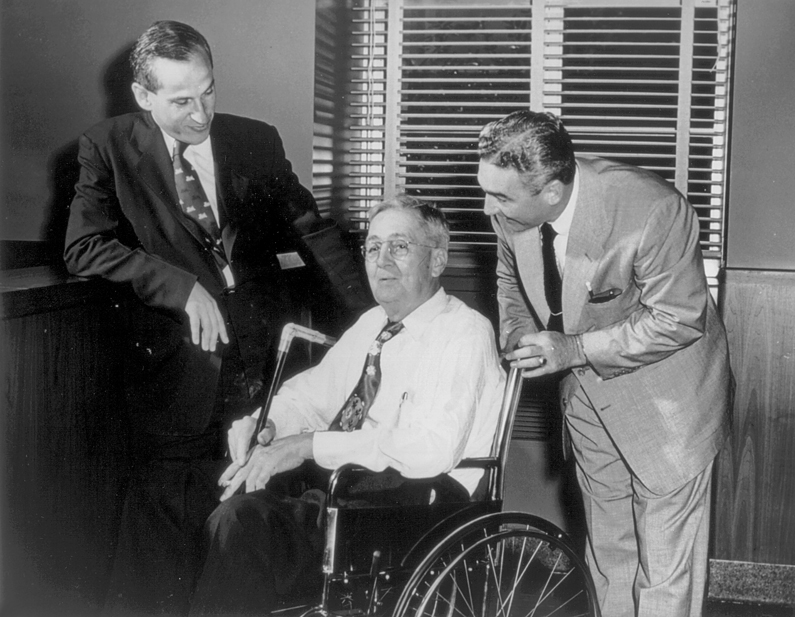"This is a noble purpose"
NIH Clinical Center celebrates its 70th year of operation

The NIH Clinical Center is one of 27 Institutes and Centers each with a specific research agenda, often focusing on particular diseases or body systems.
The Clinical Center is where NIH houses its Intramural program, which focuses on patient care and laboratory research on the NIH campus. That research takes place not only in the Clinical Center but also in labs across the campus.
The NIH campus is on 322 acres of land with more than 100 buildings and its own fire and police departments.
NIH has approximately 20,000 federal employees, not including contractors. The Clinical Center itself has about 2,000 federal employees.
The Clinical Center was built in three stages:
- The Magnuson Center, named after Senator John Magnuson from Washington State, which housed 552 inpatient beds, opened in 1953.
- The Ambulatory Care Unit or Outpatient Unit opened in 1983 and holds 150 examination rooms.
- The Hatfield Center, named after the Senator Mark O. Hatfield from Oregon, opened in 2005 and now hosts 200 inpatient beds.
There are three day hospitals: pediatrics, medical-surgical and oncology with 93 bed or chair stations.
While designing the Hatfield Center, a Patient Advisory Group provided advice on the design, feel and look of patient rooms and the hospital atrium.
Medicinal plants are found throughout the building. Greenery was selected through collaboration with the Botanic Garden.
The building is designed to meet the needs of both patients and researchers. Patients receive top-notch services and researchers have state-of-the-art equipment.
The Clinical Center is planning additional improvements. Work has begun on an 8-story Surgery, Radiology and Laboratory Medicine wing attached to the northwest side of the hospital. This will eventually connect to a new parking garage and pedestrian tunnel to the Clinical Center.
"We are here today to lay the cornerstone of a building which will be devoted to the service of mankind. The men and women who work in this clinical research center will be striving to save human lives and to prevent human suffering. This is a noble purpose."
These words came from President Harry S. Truman at the dedication of the National Institutes of Health Clinical Center in June 1951. These words still ring true today.
The NIH Clinical Center, the world's largest hospital devoted to clinical research, opened its doors in July 1953 with a focus on improving public health. The first patient was a Maryland farmer named Charles Meredith who came to the Clinical Center for cancer treatment. Since then, more than half a million patient volunteers from all 50 states and from all over the world have participated in clinical research at the hospital.
Approximately 1,500 studies are in progress at the Clinical Center. About half the studies are the first tests of new medications or medical treatments in people. The rest are natural history studies of diseases, including many rare diseases. About 10,000 diseases are identified as rare and considered to impact fewer than 200,000 people in the U.S. Natural history studies lead to better understanding of how diseases develop and to improvements in prevention and treatment.
The Clinical Center has gone through many expansions and changes, but remains steadfastly true to its mission to provide hope through pioneering clinical research to improve human health.
In 2023, the hospital celebrates seven decades of supporting "firsts" – first innovations on diagnoses for disease, first applications of technology and novel approaches and first treatments for its patients.
Research discoveries at the Clinical Center include:
- Discovering fluoride's ability to prevent tooth decay
- Developing the test to diagnose cervical cancer
- The first chemotherapy treatment for childhood leukemia and Hodgkin's disease
- The first use of immunotherapy to treat the cancer melanoma
- The first use of AZT (azidothymidine) for the treatment of AIDS (Acquired Immune Deficiency Syndrome)
- The first blood tests for hepatitis and AIDS, which made the national blood supply safer
- The first gene therapy which transplants healthy genes into cells to replace missing or defective genes and correct genetic disorders
- The first controlled trials of lithium's effect on depression
- Developing treatments for Ebola and Covid-19
This celebration looks fondly at the Clinical Center's past, its partnership with patients, their families and staff and the promise of the future as the hospital continues to innovate and provide a model environment for clinical research, patient care and training future generations of clinician scientists.
As Truman said in concluding his remarks:
"The work that is done here in Bethesda will bring life and health to all mankind. This center is a specific and exciting expression of man's humanity to man. It will save the lives and alleviate the suffering of our own children and grandchildren. But, more than that, it will serve men of all religions, all races, and all nations - everywhere in the world."
Learn more about the Clinical Center's history and upcoming events celebrating the hospital.
- Donovan Kuehn